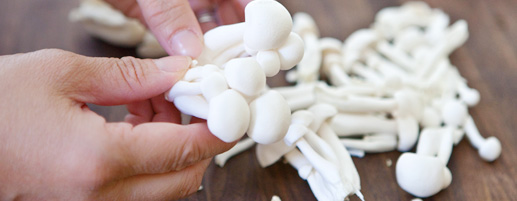
Now that the introductions are out of the way, are you’re ready to try a rather exotic looking mushroom but not sure how to begin? Wash? Rinse? Peel? The good news is that Hokto’s mushrooms are ready to be cooked right out of the bag. They do not need to be washed, rinsed, or peeled because they are not grown in dirt and are completely bug-free!
As I’m sure you’ve heard, conventional mushroom farming has a connotation of being a dirty process done in the dark and involving manure. In fact, the popular television show “America’s Dirtiest Jobs” had a segment on mushroom farming. Producers shot the episode on a button mushroom farm. Button mushroom farms, in general, fit this description.
Now imagine growing mushrooms without dirt! What’s unique about the Hokto Kinoko Company’s mushroom cultivation process is that it involves no dirt or manure and is done indoors in hygienic, environmentally controlled growing rooms. Mushrooms grow in 100% non-genetically modified culture media made from corncob meal and rice bran, providing all the necessary nutrients to the mushrooms without the need for soil.
Introduction to the Varieties
White Beech, Brown Beech, Maitake and King Trumpet may be exotic to some –all contribute unique and satisfying delights. The White Beech, or Bunapi®, mushroom offers a surprising combination of crunchy texture and smooth, nutty flavor. It’s counterpart, the Brown Beech mushroom, or Bunashimeji, has a nutty, buttery flavor, and a firm, crunchy texture. They are best enjoyed after cooking, by following the preparation instructions below.
The King Trumpet and Maitake mushrooms have a more firm and meaty texture, and a mild to robust, classic, earthy flavor that intensifies during cooking.
Basic Preparation and Cooking Techniques
As discussed, there is no need to rinse, peel, or wash the mushrooms. The only trimming needed is the end portion that grew out of the nutrient rich substrate (a combination of corn and soybean mixture).
Separate the mushroom clusters. All varieties can be sliced thick or thin, cut in quarters, coarsely or finely chopped using a sharp knife. Or they can be left whole, as shrinkage occurs and some palates prefer to see the original shape rather than a diced chunk.
Grilling or Broiling:
This is the preferred method for the larger mushrooms, like the Maitake and King Trumpet, as high heat develops characteristic flavor. Lightly brush caps and stems with oil to keep them moist, and season with salt and pepper. Grill or broil 4 to 6 inches from heat source for 4 to 6 minutes on each side, brushing again once or twice.
Microwaving:
Mushrooms cook extremely well in the microwave. Simply place eight ounces of thickly sliced mushrooms in a microwaveable bowl (no oil or butter needed as mushrooms are high in moisture); cover and cook on HIGH (100% power) for two to three minutes stirring once.
Roasting:
Place mushrooms in a shallow baking pan, drizzle with your favorite oil or spray, sprinkle with finely chopped herbs and roast in a 425ºF oven. Stir occasionally or turn large mushrooms over once and cook until browned, about 20-30 minutes. Use about one tablespoon of oil for each eight ounces of mushrooms.
Sautéing:
Sauté about 7 ounces of mushrooms over medium to high heat with butter, olive oil or a mixture of the two. As the mushrooms begin to cook, they will express liquid; continue to cook until the liquid is gone and the mushrooms are tender and browned. Season with salt, pepper or chopped herbs such as parsley. For a lower fat option, substitute a few tablespoons of wine or broth instead of oil or butter and continue cooking until the released juices have evaporated, about five minutes.
Seasoning:
Cooking mushrooms, especially at high heat, help to develop their unique and satisfying flavor. Virtually any and all seasonings go well with mushrooms. Select your favorites. If serving as a side dish, use seasonings compatible with the main dish.
Enjoy!

